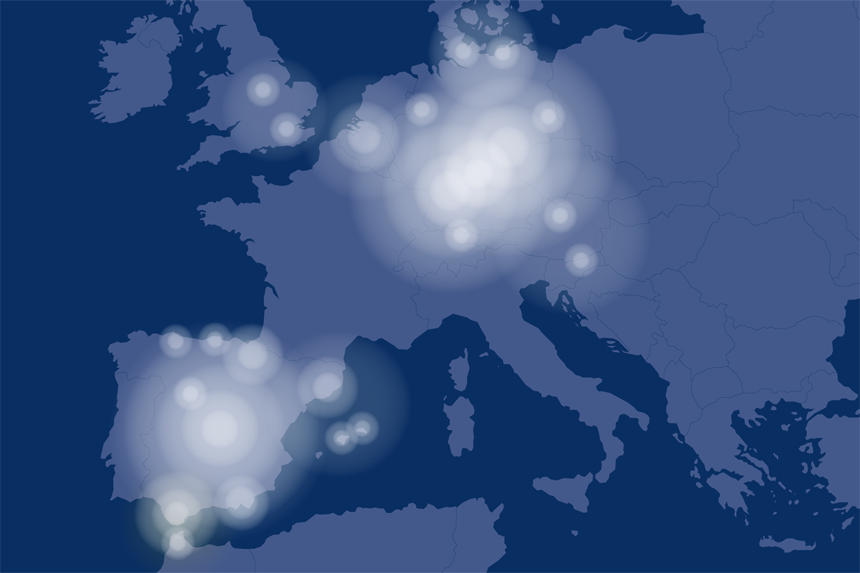Shaping the Unbuilt Environment
The Madrid-based studio Gutiérrez-delaFuente Arquitectos (GdlF) takes on a paradoxical challenge: in an almost entirely built urban landscape, they care for the unbuilt environment. Instead of focusing only on new architecture, the team led by Natalia Gutiérrez and Julio de la Fuente adapts existing spaces, revealing their hidden potential. Their approach – working with the already-there – understands the unbuilt as a crucial component of an ecological transformation. The exhibition at Aedes, curated by Kaye Geipel and Gutiérrez-delaFuente Arquitectos, presents sustainable strategies for improving in-between spaces through selected projects in Germany, Belgium, Spain, the UK and Switzerland. A central element is the film installation European Encounter Cabinet, in which international experts close to the studio share their perspectives on the future of architecture and urban planning in European cities and territories.
Gutiérrez-delaFuente Arquitectos adopt an integrative design approach that does not consider architec-ture in isolation but as part of a comprehensive environmental design. They incorporate existing buildings, open spaces and resources into their planning to develop sustainable and resilient solutions.
The studio sees itself as a mediator between the built and the unbuilt, dedicated to the rediscovery of hid-den potential. Their expanded concept of urban heritage goes beyond classical monument preservation, integrating ecological and social resources. They develop strategies that help municipalities, neighbour-hoods and investors responsibly manage water, air and soil.
For Gutiérrez-delaFuente Arquitectos, unbuilt spaces are not merely vacant areas but essential design elements. They offer opportunities to counteract social and ecological fragmentation and create resilient, inclusive urban spaces. “Landscape and, more generally, all forms of in-between spaces are key sites for seeking solutions to current climate and social crises. In our practice, we develop appropriate strategies, tactics and operational processes for new forms of interaction that promote metabolism and inclusion,” they explain.
Shaping the Unbuilt Environment, curated by Kaye Geipel and Gutiérrez-delaFuente Arquitectos, is struc-tured into two main sections:
• The European Encounter Cabinet – The Conference
• The Case Studies – A European Learning Process
In The European Encounter Cabinet, a film installation presents the cross-border collaboration of Gutiér-rez-delaFuente Arquitectos since their founding in 2006. Architects, urban planners and experts from different countries discuss the future of architecture and urban planning in Europe. Participants include Kristiaan Borret (Brussels), Aglaèe Degros (Graz), Andreas Hofer (Stuttgart), Didier Rebois (Paris), Mónica Cid and Silvia Villacañas (Madrid).
The Case Studies – projects by Gutiérrez-delaFuente Arquitectos in Germany, Belgium, Spain, the UK and Switzerland – are displayed around these European voices on the exhibition walls. They tell a story that reflects almost 20 years of architectural practice in Europe. The projects are arranged along a methodo-logical matrix illustrating the studio's specific design strategies.
Opening: March 28, 2025, 6:30 p.m.
Hans-Jürgen Commerell (Aedes, Berlin)
Kaye Geipel (Curator, Berlin/Brussels)
Natalia Gutiérrez & Julio de la Fuente (Gutiérrez-delaFuente Arquitectos, Madrid)
Collaborative Event - Intersections. Architecture of the 21st Century: April 24, 2025, 7 p.m.
Location: Instituto Cervantes Berlin, Rosenstr. 18, 10178 Berlin
Registration: www.eventbrite.de
Dialogue: Natalia Gutiérrez & Julio de la Fuente (Gutiérrez-delaFuente Arquitectos, Madrid), Ulrike Dix & Martin Fröhlich (AFF Architekten, Berlin)
Presentation: Hilde Léon (Architect, Berlin)
